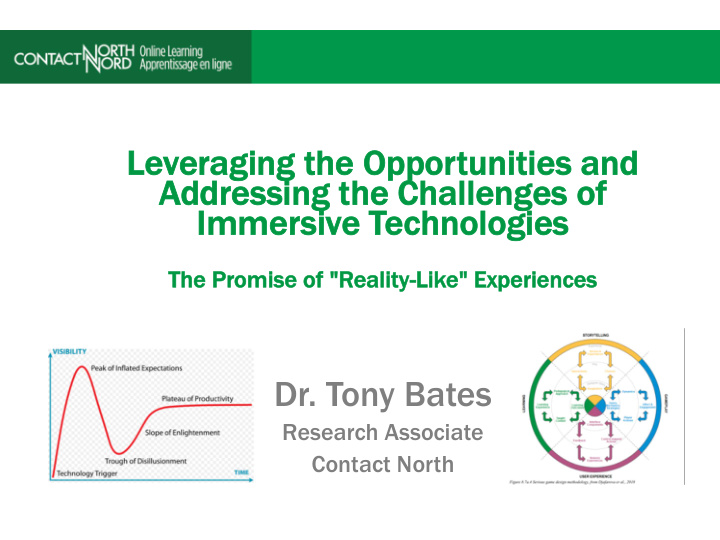



Leveraging t the O Opportunities a and Addressing t the C Challenges o of f Immersive T Technologies The Pr Promise o of " "Reality-Like" E Experiences Dr. Tony Bates Research Associate Contact North www.contactnord.ca
Webinar F Format Aim of series: • Discuss issues raised in Teaching in a Digital Age • Draw on your experiences in addressing these and related issues This webinar: • Immersive technologies (Chapters 8.7a and 8.7.b)
To Topics The hype cycle Serious games Virtual and augmented reality • Definitions • Examples • Design • Strengths and weaknesses
Ga Gartner’s H Hype C Cycle
Questions a and C Comments • Which technology is currently at the top of the hype cycle in education? • How accurate or useful is the Gartner hype cycle? • Any other comments on hype in ed tech?
Se Serious Ga Games Definition: • Serious g games are… where players cultivate their knowledge and practice their skills through overcoming numerous hindrances during gaming (Zhonggen, 2019). Not necessarily electronic: e.g. cards or board games
Se Serious Ga Games Examples: • Academic integrity (Ryerson Univ.) • Home visit: branching video (Ryerson Univ.) • Web design (Red River College): gamification
Se Serious Ga Games Design (Ryerson: Djafarova+): • Learning (content; skills) • Storytelling (narrative) • Game play (puzzle, trivia) • User experience
Se Serious Ga Games Strengths: • Motivational: ‘stretch’ students • Skills development: problem solving; collaboration; correct processes • Can be low cost; templates to follow Weaknesses • Needs specialist knowledge • High risk – but high return
Questions a and C Comments • Anyone used serious games? Examples? Experience? • Where would you place serious games in the SAMR model? • Using the SECTIONS model, what are (a) benefits (b) limits of serious games? • Other questions/comments about serious games?
Virtual a and A Augmented R Reality • Augmented reality: digital ‘layer’ added to real world (Pokémon Go) • Virtual reality: fully immersive, 3D, real time; interactive • Low cost headsets, and apps (e.g. MathWorld) for learners; • Powerful cloud computing enabling complex interactions in real time
Virtual a and A Augmented R Reality Examples: VR: • Interactive chemical compounds • Conducting an orchestra AR: • Soil sciences • MathWorld
Virtual a and A Augmented R Reality Affordances: • Deep, intuitive understanding • Modelling dangerous or inaccessible environments • Avoid mistakes that affect real people (e.g. nursing) • Shorten training time in real contexts (e.g. flight simulators)
Virtual a and A Augmented R Reality Strength: • Costs are dropping; OER • Adds emotional context • Unique educational affordances Weakness: • High cost • Specialist knowledge Deep but not wide
Questions a and C Comments • Anyone used VR or AR? Examples? Experience? • Where would you place (a) VR (b) AR in the SAMR model? • Using the SECTIONS model, what are (a) benefits (b) limits of (i) virtual reality (ii) augmented reality? • Other questions/comments about games, VR or AR?
General D Discussion: Questions/Comments a about Emerging T Technologies • What other technologies are emerging (besides Games/VR/AR/AI) that may be useful for education? • How can institutions best encourage innovation/experimentation with new technologies? • ………………………?
More recommend